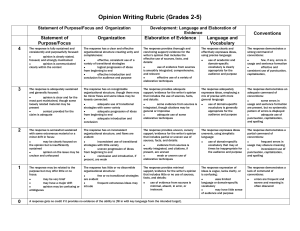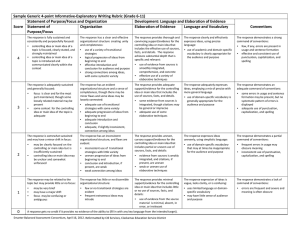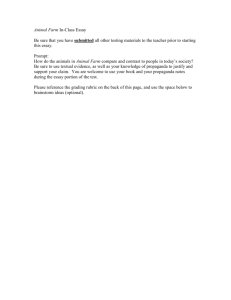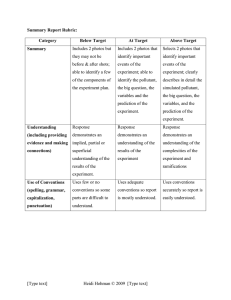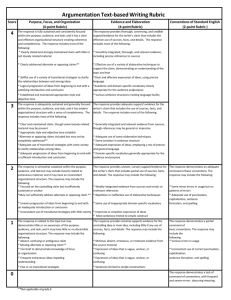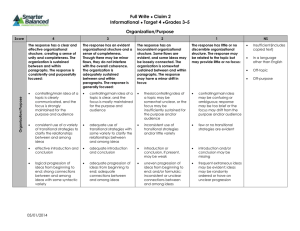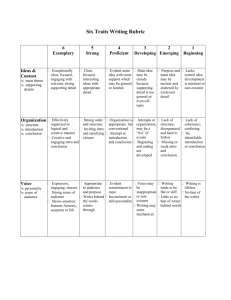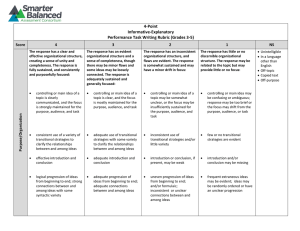Document 14891286
advertisement
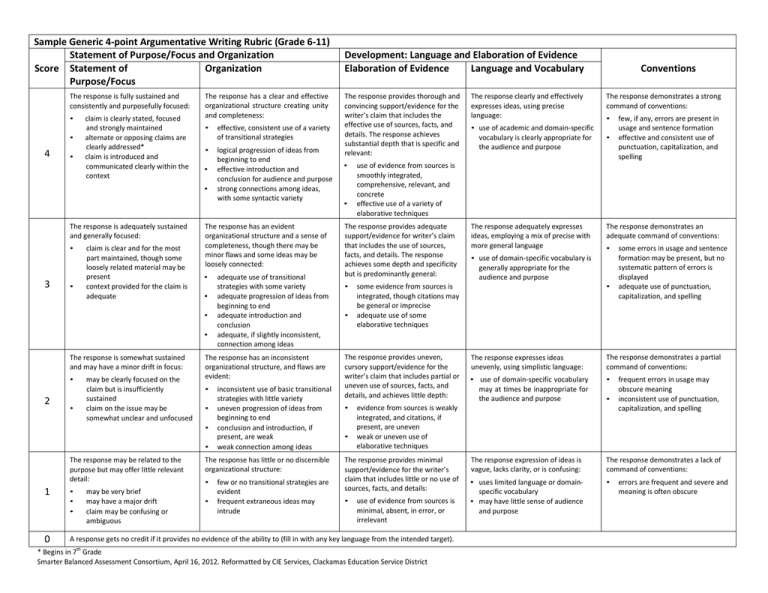
Sample Generic 4-point Argumentative Writing Rubric (Grade 6-11) Statement of Purpose/Focus and Organization Score Statement of Organization Purpose/Focus The response is fully sustained and consistently and purposefully focused: • • 4 • claim is clearly stated, focused and strongly maintained alternate or opposing claims are clearly addressed* claim is introduced and communicated clearly within the context The response has a clear and effective organizational structure creating unity and completeness: • effective, consistent use of a variety of transitional strategies • logical progression of ideas from beginning to end effective introduction and conclusion for audience and purpose strong connections among ideas, with some syntactic variety • • The response is adequately sustained and generally focused: • 3 • claim is clear and for the most part maintained, though some loosely related material may be present context provided for the claim is adequate The response has an evident organizational structure and a sense of completeness, though there may be minor flaws and some ideas may be loosely connected: • • • • The response is somewhat sustained and may have a minor drift in focus: • 2 • may be clearly focused on the claim but is insufficiently sustained claim on the issue may be somewhat unclear and unfocused The response has an inconsistent organizational structure, and flaws are evident: • • • • The response may be related to the purpose but may offer little relevant detail: 1 0 • • • may be very brief may have a major drift claim may be confusing or ambiguous adequate use of transitional strategies with some variety adequate progression of ideas from beginning to end adequate introduction and conclusion adequate, if slightly inconsistent, connection among ideas inconsistent use of basic transitional strategies with little variety uneven progression of ideas from beginning to end conclusion and introduction, if present, are weak weak connection among ideas The response has little or no discernible organizational structure: • • few or no transitional strategies are evident frequent extraneous ideas may intrude Development: Language and Elaboration of Evidence Elaboration of Evidence Language and Vocabulary The response provides thorough and convincing support/evidence for the writer’s claim that includes the effective use of sources, facts, and details. The response achieves substantial depth that is specific and relevant: • • • some evidence from sources is integrated, though citations may be general or imprecise adequate use of some elaborative techniques The response provides uneven, cursory support/evidence for the writer’s claim that includes partial or uneven use of sources, facts, and details, and achieves little depth: • • evidence from sources is weakly integrated, and citations, if present, are uneven weak or uneven use of elaborative techniques The response provides minimal support/evidence for the writer’s claim that includes little or no use of sources, facts, and details: • • use of academic and domain-specific vocabulary is clearly appropriate for the audience and purpose The response demonstrates a strong command of conventions: • • use of evidence from sources is smoothly integrated, comprehensive, relevant, and concrete effective use of a variety of elaborative techniques The response provides adequate support/evidence for writer’s claim that includes the use of sources, facts, and details. The response achieves some depth and specificity but is predominantly general: • The response clearly and effectively expresses ideas, using precise language: Conventions use of evidence from sources is minimal, absent, in error, or irrelevant A response gets no credit if it provides no evidence of the ability to (fill in with any key language from the intended target). * Begins in 7th Grade Smarter Balanced Assessment Consortium, April 16, 2012. Reformatted by CIE Services, Clackamas Education Service District The response adequately expresses ideas, employing a mix of precise with more general language few, if any, errors are present in usage and sentence formation effective and consistent use of punctuation, capitalization, and spelling The response demonstrates an adequate command of conventions: • • use of domain-specific vocabulary is generally appropriate for the audience and purpose • some errors in usage and sentence formation may be present, but no systematic pattern of errors is displayed adequate use of punctuation, capitalization, and spelling The response expresses ideas unevenly, using simplistic language: The response demonstrates a partial command of conventions: • use of domain-specific vocabulary may at times be inappropriate for the audience and purpose • The response expression of ideas is vague, lacks clarity, or is confusing: The response demonstrates a lack of command of conventions: • uses limited language or domainspecific vocabulary • may have little sense of audience and purpose • • frequent errors in usage may obscure meaning inconsistent use of punctuation, capitalization, and spelling errors are frequent and severe and meaning is often obscure
